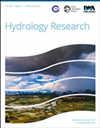喀麦隆贝努埃河流域上游概念集总模型的敏感性和可识别性分析:对不确定性量化和参数优化的影响
IF 2.4
4区 环境科学与生态学
Q2 Environmental Science
引用次数: 0
摘要
许多水文应用采用概念集中模型来支持水资源管理技术。本研究旨在评估将每日时间步长概念集总模型HYdrological model(HYMOD)应用于贝努埃河源头流域(HBRB)以进行未来水资源管理的可行性。本研究结合了局部和全局灵敏度分析(SA)方法,重点关注哪些模型参数对模型输出的影响最大。它还确定了模型参数在模型结构中的定义情况,使用六个性能标准来预测模型的不确定性并提高模型性能。结果表明,两种SA方法在对模型输出的敏感参数方面给出了相似的结果,这些参数也是模型结构中识别良好的参数。模型参数在小范围内约束得越精确,模型的不确定性就越小,因此模型性能就越好。关于测量流量的最佳模拟位于行为参数集的模型不确定性预测的窄带内。这突出表明,模拟流量与观测结果吻合良好,表明水文模型的良好性能以及使用HYMOD估算研究区域河流流量长时间序列的可行性。本文章由计算机程序翻译,如有差异,请以英文原文为准。
Sensitivity and identifiability analysis of a conceptual-lumped model in the headwaters of the Benue River Basin, Cameroon: implications for uncertainty quantification and parameter optimization
Many hydrological applications employ conceptual-lumped models to support water resource management techniques. This study aims to evaluate the workability of applying a daily time-step conceptual-lumped model, HYdrological MODel (HYMOD), to the Headwaters Benue River Basin (HBRB) for future water resource management. This study combines both local and global sensitivity analysis (SA) approaches to focus on which model parameters most influence the model output. It also identifies how well the model parameters are defined in the model structure using six performance criteria to predict model uncertainty and improve model performance. The results showed that both SA approaches gave similar results in terms of sensitive parameters to the model output, which are also well-identified parameters in the model structure. The more precisely the model parameters are constrained in the small range, the smaller the model uncertainties, and therefore the better the model performance. The best simulation with regard to the measured streamflow lies within the narrow band of model uncertainty prediction for the behavioral parameter sets. This highlights that the simulated discharges agree with the observations satisfactorily, indicating the good performance of the hydrological model and the feasibility of using the HYMOD to estimate long time-series of river discharges in the study area.
求助全文
通过发布文献求助,成功后即可免费获取论文全文。
去求助
来源期刊

Hydrology Research
Environmental Science-Water Science and Technology
CiteScore
5.30
自引率
7.40%
发文量
70
审稿时长
17 weeks
期刊介绍:
Hydrology Research provides international coverage on all aspects of hydrology in its widest sense, and welcomes the submission of papers from across the subject. While emphasis is placed on studies of the hydrological cycle, the Journal also covers the physics and chemistry of water. Hydrology Research is intended to be a link between basic hydrological research and the practical application of scientific results within the broad field of water management.
 求助内容:
求助内容: 应助结果提醒方式:
应助结果提醒方式:


